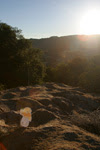
Flat Stanley is visiting with us for a week or so. He hails from Flat Rhode Island, where he lives with a fellow blogger, her husband, and their three kids (Jacob, Zachary, and Kaileigh). He’s visiting with us as part of an educational program to teach the family about what it’s like in other parts of the country. We volunteered to host Flat Stanley out here in our California home. This is the first of several journal entries about Flat Stanley’s visit here.
Flat Stanley has a major travelling advantage over the rest of us, especially in these days of high gasoline prices. You see, Flat Stanley is so flat that he fits quite nicely into a Priority Mail envelope — so he got to travel all the way across the country for about $5. Pretty darned good deal, Flat Stanley!
This morning just after sunrise, Debbie (my wife), I, and our three field spaniels all went for a walk up the old, disused dirt road that goes uphill from our property. We’ve taken this walk — about a mile each way — many, many times. The road wanders slowly uphill from our house, around small chaparral-covered hills. There are interesting things to see all along the way, changing with every season. And there are very pleasant views of our valley (Lawson Valley) that are different as you walk around every corner.
In the summertime our area usually gets very warm every afternoon — often the temperature goes over 95 degrees Fahrenheit, and on the hottest days it goes over 105 degrees. That sounds just awful to anyone used to the temperatures on the East coast of the U.S. — but the heat here “feels” very different, because our relative humidity is so much lower. Whereas back East it’s very common for the relative humidity to be 90% or even 100%, here the usual relative humidity during the day is less than 20% — and sometimes less than 10%. This very dry air makes the heat much easier to bear, mostly because sweating cools you off much more effectively.
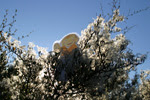
Flat Stanley seemed to like just sitting around more than he did climbing our hill. Since he’s so used to Flat Rhode Island, we’re thinking it might be the thin air at our altitude that’s got him feeling lazy. At the top of this road, we were about 2,300 feet above the ocean — much higher than the very highest place in all of Rhode Island. And in other parts of California, there are huge mountains that are almost seven times taller than where we walked with Flat Stanley.
In any case, Flat Stanley seemed to enjoy sitting in these Mountain Mahogany bushes more than anywhere else. These are a very common chaparral shrub, and very pretty this time of year when their seeds are out. If you touch the seeds, you’ll see that they are very soft — they make a very comfortable resting spot for Flat Stanley. When the sun shines from behind them, the Mountain Mahogany seeds are bright white, and from a distance they look like flowers. This time of year, if we look out over the chaparral, we see these white “flowered” bushes everywhere we look.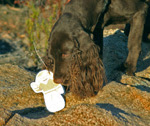
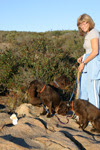
All three of our dogs (Miki, Mo’i, and Lea, front-to-rear) got along just fine with Flat Stanley. Mo’i (in the closeup) and Flat Stanley had several long conversations while on our walk. As best we could tell, Mo’i was asking Flat Stanley whether he’d make a good snack (Mo’i is always thinking about food!), and Flat Stanley was telling Mo’i how awful he would taste. Mo’i didn’t eat Flat Stanley, so he must have been persuasive!
Mo’i and Lea run in agility competition (Debbie is their trainer and handler). In these competitions they have to run through a complicated obstacle course, with jumps, tunnels, poles to weave through, and other challenging things. To win, they have to go through the entire obstacle course perfectly — and do it really fast! Mo’i is currently the #2 agility field spaniel in the U.S., and because of that he’ll be travelling to Long Beach, California in December to be part of a nationwide contest. He’s real excited about that (and so is Debbie!). The rest of us are very proud of the two of them.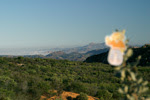
After he climbed this bush, Flat Stanley could see the view out toward the Pacific Ocean. This morning, like many summer mornings, the lower altitudes toward the shore had a layer of low clouds over them. From our higher vantage point, all we could see was the cloud tops. If we were at the beach, we wouldn’t see the sun at all — just a layer of gray clouds.
Sometimes this layer of white clouds looks to us like a kind of fantastical ocean, with the mountain tops poking out as though they were islands in the sea. These clouds are especially beautiful in the light of a bright full moon — they have a wispy look, like the poufiest meringue in the world.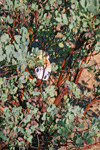
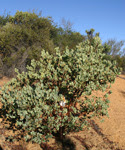
Anybody who knows the chaparral knows the manzanita tree, one of the most interesting and most beautiful plants that grows here. Flat Stanley took one look at this little manzanita and immediately jumped up to rest for a while in its shade. Manzanita trees are very common in the area immediately surrounding our home. We live in exactly the kind of area they like: the north-facing slope of a hill, with soil made from decomposed granite that drains extremely well. Manzanitas are very well adapted to the hot, dry climate we live in. They have a very broad system over hairlike roots just under the surface of the ground — these roots catch every drop of rain (or dew) that falls on them. The manzanita’s leaves are covered with very fine hairs, almost like velvet. These hairs act as a layer of insulation, keeping the hot sun off the leaves and helping them retain water. The light green color of their leaves also helps them stay cooler — and they are beautiful against the deep red bark.
Climbing a different bush, and looking in a different direction, Flat Stanley could see Cajon Mountain. It looks very big and rugged in this photo, but it’s actually only a medium-sized mountain in our area. The rocky faces of Cajon Mountain are a famous landmark here, especially from the town of El Cajon, which is named after the mountain.
Three years ago, a terrible wildfire burned large parts of the county (San Diego County) where we live. Hundreds of houses were burned down, and many square miles of wild forest and chaparral were also burned. All of Cajon mountain was burned in that fire, and even though it’s 15 miles away from us in that picture, you can still see some of the black, charcoal-like marks the fire caused on the rocks.
For people, these wildfires are awful things, and we do our best to prevent them and put them out. But it is interesting to know that the chaparral plants and animals actually depend on these fires occurring, usually every 50 to 100 years. Many of the shrubs and trees that live in the chaparral have seeds that will not sprout unless there is a fire (the manzanita tree is one of these).
Flat Stanley got really tired on this walk, and now he’s taking a nap in his envelope. We’ll have another Flat Stanley adventure tomorrow…

No comments:
Post a Comment